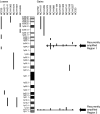Genomic and gene expression profiling of minute alterations of chromosome arm 1p in small-cell lung carcinoma cells
- PMID: 15785753
- PMCID: PMC2362006
- DOI: 10.1038/sj.bjc.6602452
Genomic and gene expression profiling of minute alterations of chromosome arm 1p in small-cell lung carcinoma cells
Abstract
Genetic alterations occurring on human chromosome arm 1p are common in many types of cancer including lung, breast, neuroblastoma, pheochromocytoma, and colorectal. The identification of tumour suppressors and oncogenes on this arm has been limited by the low resolution of current technologies for fine mapping. In order to identify genetic alterations on 1p in small-cell lung carcinoma, we developed a new resource for fine mapping segmental DNA copy number alterations. We have constructed an array of 642 ordered and fingerprint-verified bacterial artificial chromosome clones spanning the 120 megabase (Mb) 1p arm from 1p11.2 to p36.33. The 1p arm of 15 small-cell lung cancer cell lines was analysed at sub-Mb resolution using this arm-specific array. Among the genetic alterations identified, two regions of recurrent amplification emerged. They were detected in at least 45% of the samples: a 580 kb region at 1p34.2-p34.3 and a 270 kb region at 1p11.2. We further defined the potential importance of these genomic amplifications by analysing the RNA expression of the genes in these regions with Affymetrix oligonucleotide arrays and semiquantitative reverse transcriptase-polymerase chain reaction. Our data revealed overexpression of the genes HEYL, HPCAL4, BMP8, IPT, and RLF, coinciding with genomic amplification.
Figures




Similar articles
-
Genetic profiling of chromosome 1 in breast cancer: mapping of regions of gains and losses and identification of candidate genes on 1q.Br J Cancer. 2006 Nov 20;95(10):1439-47. doi: 10.1038/sj.bjc.6603433. Epub 2006 Oct 24. Br J Cancer. 2006. PMID: 17060936 Free PMC article.
-
High-resolution mapping of amplicons of the short arm of chromosome 1 in two neuroblastoma tumors by microarray-based comparative genomic hybridization.Genes Chromosomes Cancer. 2004 Jul;40(3):266-70. doi: 10.1002/gcc.20041. Genes Chromosomes Cancer. 2004. PMID: 15139005
-
High-resolution chromosome arm 5p array CGH analysis of small cell lung carcinoma cell lines.Genes Chromosomes Cancer. 2005 Mar;42(3):308-13. doi: 10.1002/gcc.20137. Genes Chromosomes Cancer. 2005. PMID: 15611929
-
Oligonucleotide microarray analysis of gene expression in neuroblastoma displaying loss of chromosome 11q.Carcinogenesis. 2004 Sep;25(9):1599-609. doi: 10.1093/carcin/bgh173. Epub 2004 Apr 16. Carcinogenesis. 2004. PMID: 15090470 Review.
-
Analysis of genomic imprinting at 1p35-36 in neuroblastoma.Med Pediatr Oncol. 2001 Jan;36(1):52-5. doi: 10.1002/1096-911X(20010101)36:1<52::AID-MPO1014>3.0.CO;2-8. Med Pediatr Oncol. 2001. PMID: 11464906 Review.
Cited by
-
Lung cancer cell lines: Useless artifacts or invaluable tools for medical science?Lung Cancer. 2010 Jun;68(3):309-18. doi: 10.1016/j.lungcan.2009.12.005. Epub 2010 Jan 15. Lung Cancer. 2010. PMID: 20079948 Free PMC article. Review.
-
YB-1 is a Transcription/Translation Factor that Orchestrates the Oncogenome by Hardwiring Signal Transduction to Gene Expression.Transl Oncogenomics. 2007 May 11;2:49-65. Print 2007. Transl Oncogenomics. 2007. PMID: 23641145 Free PMC article.
-
Hepatitis C virus core impacts expression of miR122 and miR204 involved in carcinogenic progression via regulation of TGFBRAP1 and HOTTIP expression.Onco Targets Ther. 2018 Mar 2;11:1173-1182. doi: 10.2147/OTT.S149254. eCollection 2018. Onco Targets Ther. 2018. PMID: 29535540 Free PMC article.
-
DNA amplification is a ubiquitous mechanism of oncogene activation in lung and other cancers.Oncogene. 2008 Jul 31;27(33):4615-24. doi: 10.1038/onc.2008.98. Epub 2008 Apr 7. Oncogene. 2008. PMID: 18391978 Free PMC article.
-
Characterizing the Genetic Basis for Nicotine Induced Cancer Development: A Transcriptome Sequencing Study.PLoS One. 2013 Jun 18;8(6):e67252. doi: 10.1371/journal.pone.0067252. Print 2013. PLoS One. 2013. PMID: 23825647 Free PMC article.
References
-
- Artavanis-Tsakonas S, Rand MD, Lake RJ (1999) Notch signaling: cell fate control and signal integration in development. Science 284: 770–776 - PubMed
-
- Ashman JN, Brigham J, Cowen ME, Bahia H, Greenman J, Lind M, Cawkwell L (2002) Chromosomal alterations in small cell lung cancer revealed by multicolour fluorescence in situ hybridization. Int J Cancer 102: 230–236 - PubMed
-
- Brubaker KD, Corey E, Brown LG, Vessella RL (2004) Bone morphogenetic protein signaling in prostate cancer cell lines. J Cell Biochem 91: 151–160 - PubMed
-
- Buckley PG, Mantripragada KK, Benetkiewicz M, Tapia-Paez I, Diaz De Stahl T, Rosenquist M, Ali H, Jarbo C, De Bustos C, Hirvela C, Sinder Wilen B, Fransson I, Thyr C, Johnsson BI, Bruder CE, Menzel U, Hergersberg M, Mandahl N, Blennow E, Wedell A, Beare DM, Collins JE, Dunham I, Albertson D, Pinkel D, Bastian BC, Faruqi AF, Lasken RS, Ichimura K, Collins VP, Dumanski JP (2002) A full-coverage, high-resolution human chromosome 22 genomic microarray for clinical and research applications. Hum Mol Genet 11: 3221–3229 - PubMed
-
- Cerretti DP, DuBose RF, Black RA, Nelson N (1999) Isolation of two novel metalloproteinase-disintegrin (ADAM) cDNAs that show testis-specific gene expression. Biochem Biophys Res Commun 263: 810–815 - PubMed
Publication types
MeSH terms
Grants and funding
LinkOut - more resources
Full Text Sources
Other Literature Sources
Medical
Miscellaneous

